Lifestyle Interiors – Designs on a Life Less Ordinary
Case Study
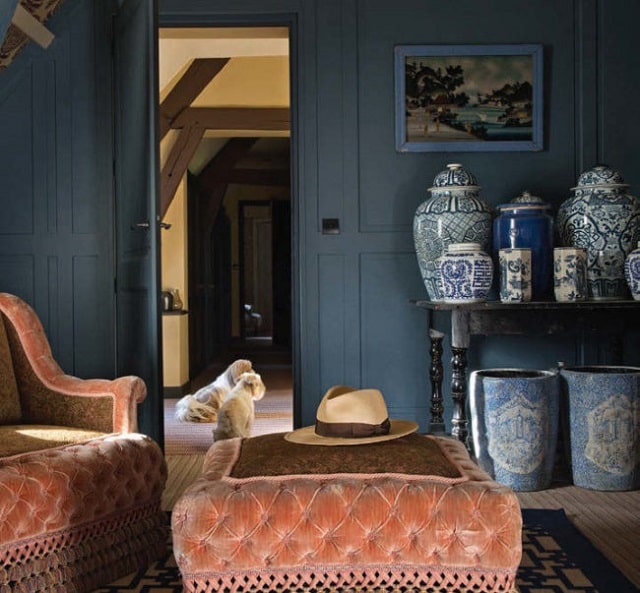
Fashions come and go, but Pierre Sauvage, director of homewares company Casa Lopez, has his finger firmly on the pulse. Here he tells Marion Sauvebois how he put his keen eye for style to work when renovating his homes and shares his top interior design tips…
In his first design ‘manifesto’, Effortless Style, director of luxury housewares firm Casa Lopez, Pierre Sauvage, invites readers inside his freshly renovated 18th-century Parisian apartment, rustic Norman farmhouse and Provençal summer home. We chat to the public relations guru turned interior designer about juggling three renovation projects, his inspiration, audacious colour and pattern pairings and style hacks.
How would you describe your aesthetic?
I love colour and classic structures with striking floors. I especially love rugs. My style is quite Anglo-Saxon in nature. I love comfort. A beautiful chair that is uncomfortable is pointless. I’m not an interior designer, the book is not a lesson in style. This is how I like to live. I have classic taste and I choose what suits me.
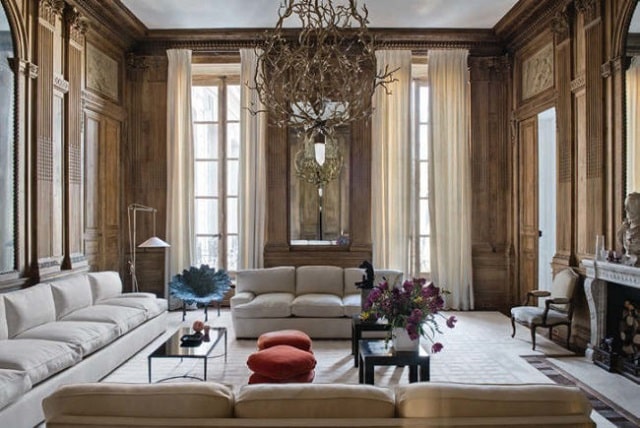
What prompted you to leave a successful career to start afresh as the director of housewares firm Casa Lopez?
I worked in public relations for 20 years. I started in fashion at Dior and Castelbajac and then started working at a big design firm, Véronique Lopez. She actually owned Casa Lopez and that’s how I discovered the brand. I had accompanied so many business owners and creators on their journeys and I thought ‘Why don’t I give it a try?’. It’s the classic scenario, I changed careers at 40. I couldn’t see myself in public relations for another 20 years. I tried to buy Casa Lopez several times but the owners kept saying no. Eventually they gave in.
How did you approach each renovation? What were the biggest challenges?
The most difficult part was sorting through all my ideas. You can’t have a 19th-centurystyle living room and have statement rugs, or strong colours, as it will clash. I always have lots of ideas and think, ‘In the next flat I’ll do this, have a conservatory etc’. But it all needs to sit with the space. It’s easier to have strong statement floors if you are working with large spaces, or high ceilings. Some apartments will lend themselves well to 19th-century interiors. In my Normandy country home, I wanted something that would be very comfortable, English-cottage inspired, with florals and lots of greenery.
In Paris I wasn’t sure about the bedroom. I was thinking of using a navy blue, but I realised, talking to my architect, that it would be too dark, so I used electric blue instead.
One thing is certain – if you’re not completely sure about something at the time of designing, it’s unlikely to grow on you later.
I think it’s always easier to start from a single element or object, a colour you like, and build everything round it. It sets the tone and helps focus the mind. For me, it often starts with a rug and you build everything round it.
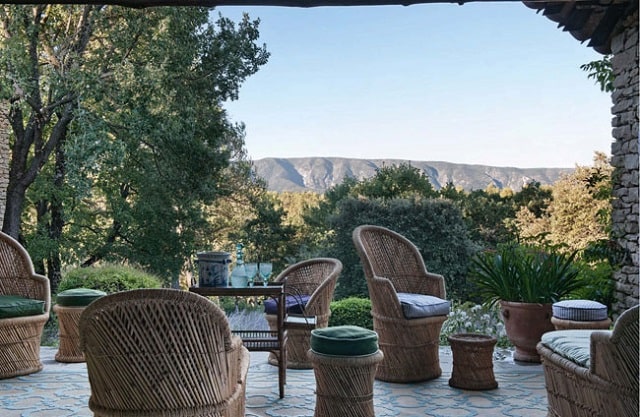
You worked with an architect on every project. Is enlisting the help of a professional key to a successful renovation?
It is important to have a dialogue with someone – especially when you get stuck – like an architect or a contractor. Or you could use your partner or a friend as a sounding board, but I think using a professional helps. In the countryside, I wanted to use green and purple but it didn’t work, so I spoke to my architect about it. We decided to add red and suddenly it just clicked.
What is your favourite room in each of your three homes?
In Normandy, I love the living room. It’s very small with a huge fireplace. It’s warm and cosy. I used thick curtains, just like blankets, so when you draw them it feels like a cocoon.
In Provence, my favourite spot is the terrace. I set it up like a living room and there’s a beautiful view of the Luberon.
In Paris, I spend most of my time in the library – it has a beautiful fireplace – and my bathroom. I love rooms where you can relax; it’s key for me.
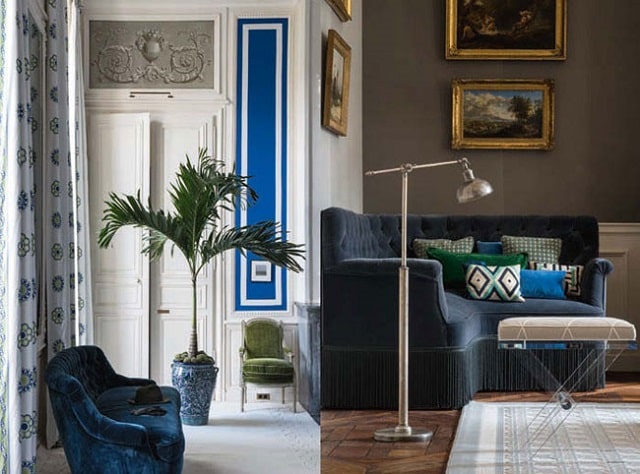
What do you think are the most common interior design misconceptions?
There is no right and wrong choice. There may be one choice that’s not quite as right as another, but in design there are a great many ‘right choices’. And you can always change your mind later if you want. If the curtains you’ve chosen don’t work, you can always take them down.
Many people think you can create the illusion of space by placing lots of small items of furniture everywhere. On the contrary, if the room is small, use imposing furniture. If the bedroom is tiny, buy a four-poster bed. Having a large cosy sofa for example is what gives a room scale, rather than choosing a minuscule sofa that’s uncomfortable so you can squeeze in a coffee table.
What are your top tips for styling or freshening up a room?
If you have really busy walls in a room, with heavy motifs, choose a neutral rug for the floor. Or if you have a busy rug, make sure your walls are neutral. Changing rugs, walls or curtains, can really alter a room, and brighten up the space.
And if a room opens onto another, make sure the floors and walls in each work together. That’s not to say they should be the same in both rooms, but you want harmony.
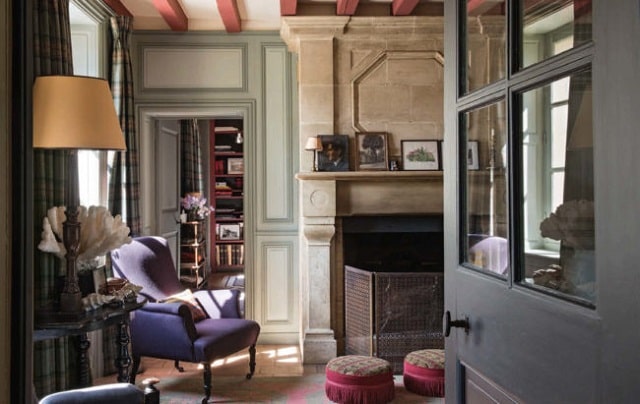
Where do you source accessories, antiques and decorative objects?
I go to auction houses like Drouot, once or twice a month, brocantes or antique shops. And I source a lot online. You can find so much on the internet, it’s very handy.
What are your thoughts on colour?
I love colours. I think paintings always stand out against darker hues and it flatters the skin too. I hate it when only one wall is painted. It doesn’t make a strong statement.
Now that all three homes are complete, do you find yourself mentally redesigning every nook and cranny? Are you constantly tempted to start over again?
I am certainly not tempted to redo everything! Although that’s how it started in the country house. I changed one thing and then nothing fitted anymore, so I changed another and another. The moment you change one room, you want to tackle everything. That’s the problem with holiday homes. If you can’t afford it, don’t touch anything. Once you start, it’s hard not to finish! I am quite happy to enjoy my homes now. We finished the country house seven years ago, Paris four years ago and the Luberon three years ago. But of course, it’s never completely over. You always want to buy something new; there is always something missing, a piece of furniture you must have…
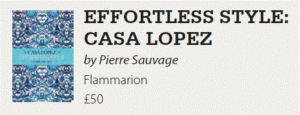
Share to: Facebook Twitter LinkedIn Email
Leave a reply
Your email address will not be published. Required fields are marked *



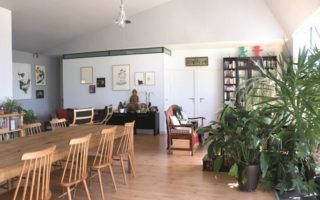
REPLY